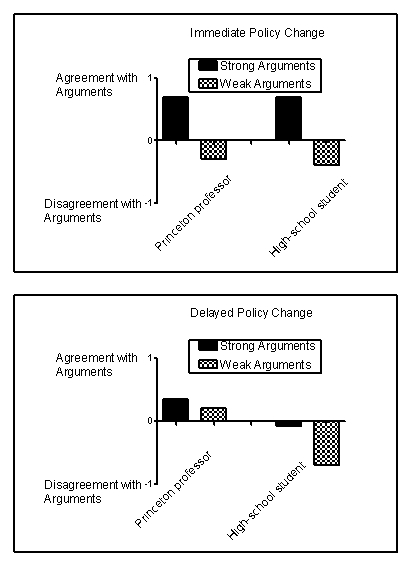Scenario II
The following scenario contains fabricated results consistent with the following study:
Petty, R. E., Cacioppo, J. T., & Goldman, R. (1981) . Personal involvement as a determinant of argument-based persuasion. Journal of Personality and Social Psychology, 41, 847-855.
Every day, consumers are exposed to scientifically based sales, marketing, and public relations strategies designed to influence purchasing decisions, change opinions, or win votes. One common sales strategy is the foot-in-the-door technique, a method that involves first making a smaller request that consumers are likely to grant and then following it by a larger request. Another common strategy is the door-in-the-face technique, which involves making an unreasonably large request that consumers will reject and then following it by a smaller request. When persuasion is necessary, it usually takes one of two forms: heuristic persuasion involves an appeal to habits or emotion, and systematic persuasion involves an appeal to facts and reason. Often, people will rely more on heuristics-simple short-cuts or "rules of thumb"-to make decisions instead of systematically weighing the evidence.
Petty and colleagues (1981) investigated some of these techniques in college students listening to arguments in favor of their college requiring an institution-level comprehensive final examination for graduation. Some students were led to believe that, if adopted, this policy would take place right away, and some were led to believe that the change would take place in a decade. In addition, some of the students were led to believe that they were listening to an argument from a Princeton professor, and others were led to believe that they were listening to an argument from a high-school student. Finally, some students heard strong arguments in favor of the policy, and some heard weak arguments. Thus, the experiment arranged six groups of students. For example, one group of students heard strong arguments from a high-school student about a far-removed policy change. Figure 13.1 shows fabricated results illustrating the major findings of this experiment.
Figure 13.1 
-(Scenario II) In the Petty et al. (1981) experiment, which is the best example of a heuristic?
Definitions:
Q3: Both challenges and threats are stressors that
Q9: Define and describe the relationships among the
Q26: The id operates on the _ principle.<br>A)morality<br>B)idealism<br>C)pleasure<br>D)reality
Q30: In Asch's classic study of conformity, about
Q36: Psychologically androgynous people probably are better adjusted
Q55: The _ states that the personality differences
Q57: By ignoring stereotypes and treating each person
Q76: Jennifer is overly dramatic and constantly seeks
Q118: The phase of the general adaptation syndrome
Q146: Which person is LEAST likely to commit